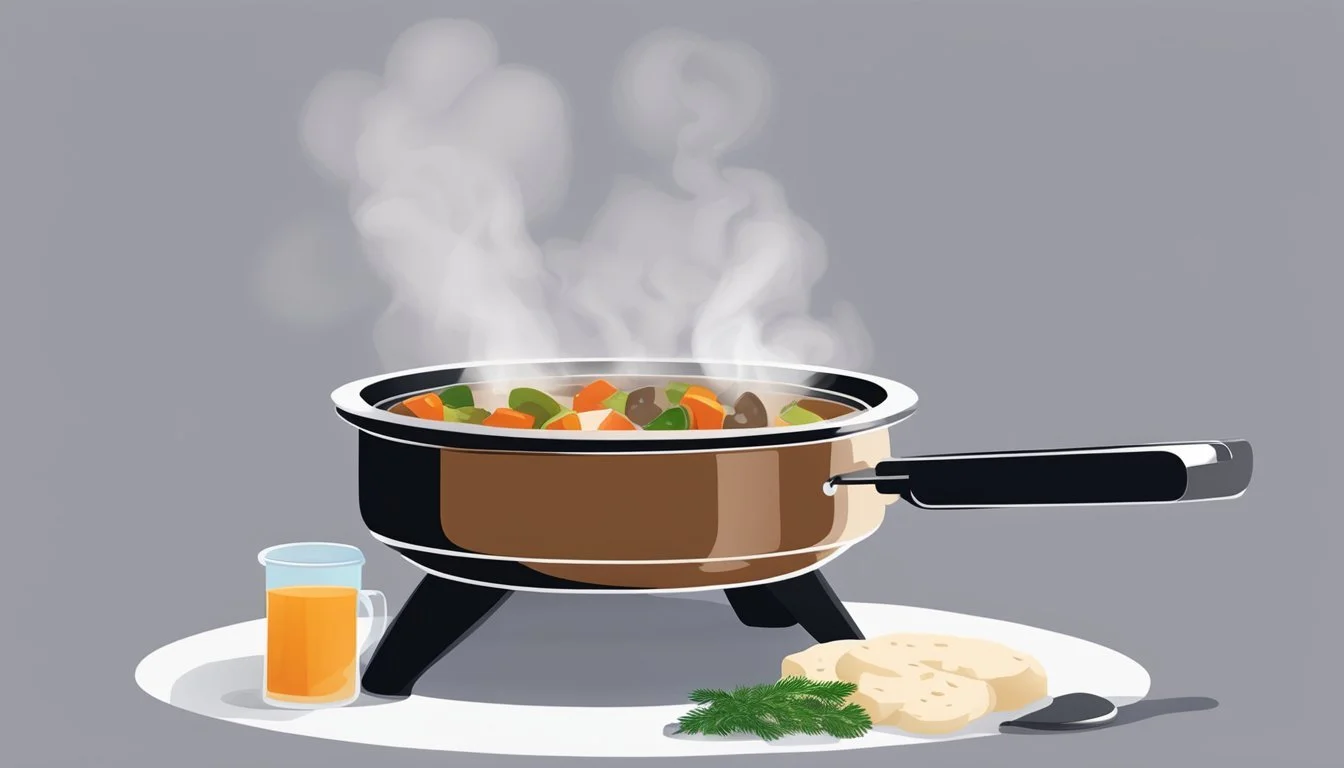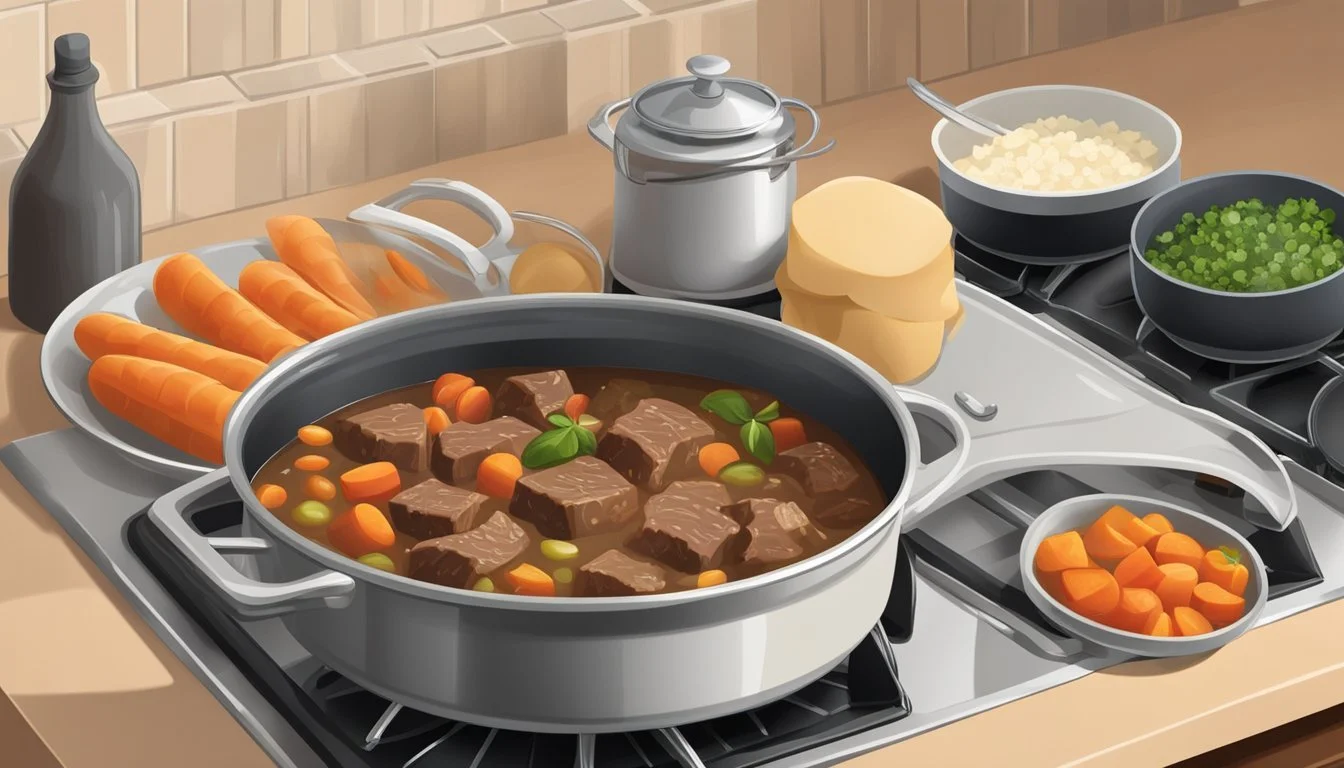How to Reheat Gluten-Free Beef Stew
Best Methods for Perfect Flavor
Reheating gluten-free beef stew can be a simple process that ensures this hearty comfort food remains flavorful and satisfying. Whether it’s for a quick dinner after a busy day or for savoring leftovers from a big family meal, there are several effective methods to restore the stew to its original delicious state. One effective method is to place the stew in an oven-safe dish, cover it with foil to prevent moisture loss, and heat it in a preheated oven at 350°F for about 25-30 minutes.
For those looking for a quicker option, reheating on the stovetop is highly recommended. By placing the stew in a pot over low heat and adding a bit of broth or water, stirring occasionally, the stew heats evenly and retains its hearty texture. This adaptable approach makes it perfect for anyone needing a comforting gluten-free meal in a pinch.
Using these techniques not only preserves the rich flavors and tender texture of the beef but also makes reheating an easy and efficient process. These methods cater to various preferences and schedules, ensuring that the gluten-free beef stew remains a go-to option for a warm and satisfying meal.
Understanding Gluten-Free Beef Stew
Gluten-free beef stew uses real ingredients and simple substitutions to create a hearty and wholesome dish. Central to its success are specific ingredients and the correct use of gluten-free flour for thickening purposes.
Key Ingredients for Gluten-Free Beef Stew
A typical gluten-free beef stew recipe includes several essential components. Lean beef chunks are browned for flavor and tenderness. Carrots and potatoes add texture and natural sweetness. Gluten-free beef broth serves as the base liquid. Other common additions include celery, onions, and garlic for added depth.
It's crucial to use fresh vegetables and high-quality gluten-free beef broth. Ingredients like tomato paste, red wine, and herbs such as rosemary and bay leaf can enhance the flavor profile significantly. This careful selection ensures the stew remains gluten-free while delivering rich taste.
The Importance of Gluten-Free Flour for Thickening
Thickening agents are vital for achieving the desired stew consistency. Gluten-free flour varieties, such as rice flour or cornstarch, replace traditional wheat flour. This substitution ensures the stew is safe for those with gluten sensitivities.
To thicken, mix the gluten-free flour with a bit of cold broth to form a slurry before adding it to the stew. Stirring this mixture into the hot stew prevents clumping. Using gluten-free flour in this way ensures the stew retains its mouthfeel and heartiness without compromising on the gluten-free requirements.
Preparation Before Reheating
Proper handling of gluten-free beef stew involves key steps to ensure safe and effective reheating. This includes appropriate storing methods, preparing with a slow cooker, and suitable freezing techniques.
Proper Storing Techniques
To maintain quality, store gluten-free beef stew in airtight containers. Refrigerate the stew within two hours of cooking to prevent bacterial growth. Use shallow containers to speed up cooling and ensure even refrigeration. For best results, consume refrigerated stew within 3-4 days.
Store the stew with a good amount of liquid, such as beef broth, to prevent drying. Label containers with the date to track freshness. Avoid using containers that might absorb the strong flavors of the beef stew, which could affect the taste.
The Role of a Slow Cooker in Preparation
A slow cooker can be instrumental in preparing beef stew for reheating. Cooking the stew initially in a slow cooker helps in blending the flavors better. This method also allows for a consistent cook, making the reheating process smoother.
When reheating, placing the stew back in the slow cooker on low heat helps maintain moisture and avoids overcooking. Make sure to stir occasionally and ensure it reaches an internal temperature of 165°F (74°C). Add additional beef broth if necessary to maintain the desired consistency.
Tips for Freezing Gluten-Free Beef Stew
Freezing ensures the long-term preservation of gluten-free beef stew. Prior to freezing, cool the stew to room temperature. Use freezer-safe, airtight containers or heavy-duty freezer bags to store the stew. To save space, fill the bags, lay them flat to freeze, and stack them later.
Consider portioning the stew into meal-sized servings for easy thawing and reheating. Label the containers with the date and contents. Frozen beef stew retains its best quality for up to three months. When ready to use, thaw it in the refrigerator overnight and reheat using preferred methods, such as on the stovetop or in a microwave.
Reheating Gluten-Free Beef Stew
For a perfectly reheated gluten-free beef stew, it’s essential to preserve its texture and flavor. Depending on the equipment available, different methods such as using an oven, stovetop, or Instant Pot can be employed.
Oven Method
To reheat gluten-free beef stew in the oven, preheat the oven to 350°F (175°C). Transfer the stew from the refrigerator to an oven-safe baking dish.
Cover the dish with foil or a lid to prevent moisture loss. Heat for around 25-30 minutes or until thoroughly warmed. Stir halfway through to ensure even heating.
The oven method is ideal for larger portions and helps maintain the stew’s rich texture.
Stovetop Technique
For stovetop reheating, transfer the stew to a pot over medium heat. Stir occasionally to avoid sticking and ensure even heating.
If the stew appears too thick, add a small amount of beef broth or water to reach the desired consistency. Heat for about 10-15 minutes or until fully heated.
This method offers quick results and is great for reheating smaller quantities.
Using an Instant Pot
Reheating in an Instant Pot is efficient and preserves the stew’s flavors well. Transfer the stew into the Instant Pot.
Use the "Sauté" mode on low, stirring occasionally to avoid burning. If the stew is thick, add broth or water as necessary. Heat thoroughly for about 7-10 minutes.
The Instant Pot is particularly useful for reheating soups and stews quickly without compromising taste or texture.
Ensuring Optimal Texture and Flavor
Enhancing the texture and flavor of reheated gluten-free beef stew requires attention to detail when adjusting seasoning and considering additional ingredients for variety.
Adjusting Seasoning After Reheating
Reheating can sometimes affect the taste and consistency of a dish. To revive and enhance flavor, check for balance and adjust seasoning as needed.
Salt and pepper are crucial for seasoning, but it’s important not to overpower the stew. Start with small amounts and taste as you go.
Adding fresh thyme can provide a herbaceous note, while a touch of tomato paste can deepen the stew's umami. For those on a dairy-free or paleo diet, ensure seasonings do not contain hidden gluten or dairy derivatives.
Consider incorporating cornstarch to thicken the stew if it has become too watery after reheating. Mix cornstarch with cold water before adding to the pot to avoid lumps.
Add-In Options for Variety
Enhancing the reheated stew's flavor can also involve adding new ingredients. Seasonal vegetables like carrots, potatoes, or even mushrooms can introduce fresh textures and flavors.
For a richer taste, consider a splash of beef broth. This liquid can both enhance flavor and provide additional moisture if the stew has dried out.
To cater to dietary preferences, include dairy-free or paleo-friendly options. For example, adding a splash of coconut milk can add creaminess without dairy, while Worcestershire sauce can boost the savory profile.
By implementing these simple adjustments and additions, the reheated beef stew can achieve a texture and flavor that rivals its freshly made counterpart.
Serving Gluten-Free Beef Stew
When serving gluten-free beef stew, consider pairing it with flavorful accompaniments and focusing on presentation to enhance the dining experience.
Recommended Accompaniments
Cornbread is a classic choice that complements the rich flavors of beef stew. Gluten-free cornbread can be made using cornmeal and gluten-free flour, ensuring a perfect side that’s safe for gluten-sensitive diners.
Biscuits provide a comforting addition, and gluten-free biscuits can be prepared with almond flour or a similar gluten-free blend. They offer a flakey texture that pairs well with the hearty stew.
Kale salad brings a fresh, nutritious contrast. The crisp leaves of kale, combined with a light vinaigrette, create a refreshing balance to the warm stew.
Gluten-free bread or dinner rolls round out a complete meal. They soak up the savory broth, adding an extra layer of satisfaction. Look for high-quality gluten-free recipes or pre-made options that maintain a similar texture and flavor to traditional bread.
Presentation Tips for a Beautiful Dish
Using wide, shallow bowls highlights the rich, colorful ingredients of the stew. A bowl that allows the stew to spread out a bit can make it visually appealing.
Garnish with fresh herbs such as parsley or thyme. This adds a pop of color and a hint of freshness to the dish.
For an elegant touch, consider arranging the vegetables on the top before serving. Carrots, potatoes, and chunks of beef should be visible to display the stew's heartiness.
Using contrasting placemats or tableware can enhance the presentation. Dark, rustic plates can make the stew’s colors stand out more.
A final drizzle of extra virgin olive oil or a sprinkle of coarse sea salt can elevate the look and amplify the flavors.
Variations and Alternatives
Different ingredients and minor adjustments can alter the flavor and nutritional profile of gluten-free beef stew. Whether swapping the meat or adjusting for dietary needs, there are plenty of ways to make this dish uniquely yours.
Substituting Meat and Vegetables
Meat Substitutions: For a different flavor, consider using chicken, turkey, or even lamb instead of beef. Each will change the stew's taste and texture slightly. For a vegan alternative, tofu or tempeh can replace meat, offering a rich, protein-packed substitute.
Vegetable Variations: Switching vegetables can refresh the stew's profile. Swap sweet potatoes for regular potatoes to add a hint of sweetness. Frozen peas and fresh peas provide color and nutritional benefits. Add tomatoes for a slightly tangy flavor, or use celery and onions to maintain a more classic taste.
Adjustments for Dietary Restrictions
Low-Sodium Options: Use low-sodium beef broth and unsalted butter to reduce sodium content. Fresh herbs like thyme and rosemary can boost flavor without added salt.
Vegetarian and Vegan Adjustments: Replace beef with plant-based protein like lentils or beans. Use vegetable broth instead of beef broth and olive oil in place of butter.
Other Dietary Needs: For those with multiple allergies, arrowroot powder offers a gluten-free thickening alternative to flour. Ensure all added ingredients, such as canned tomatoes, are certified gluten-free. When aiming for a low-carb diet, omit potatoes and use more non-starchy vegetables like zucchini and spinach.
Final Tips and Best Practices
For successful reheating of gluten-free beef stew, it is crucial to maintain a gluten-free kitchen and adapt recipes correctly, especially for beginners.
Maintaining a Gluten-Free Kitchen
Ensuring the kitchen remains gluten-free is vital to prevent cross-contamination. Utensils, cutting boards, and cookware must be thoroughly cleaned before use. Dedicated gluten-free tools help reduce risks.
When storing leftovers, use airtight containers labeled gluten-free. This avoids confusion and accidental contamination.
Ingredients should also be scrutinized. Choose products like gluten-free beef broth and verify seasoning labels for hidden gluten sources. Spices and sauces often hide gluten, which can ruin an otherwise safe dish.
Recipe Adaptation for Beginners
Beginners should start with simple, clear recipes. Opt for a basic gluten-free beef stew and gradually experiment with ingredients.
Focus on verified gluten-free items, like gluten-free beef broth and dairy-free substitutes. These products simplify the adaptation process and ensure safety without compromising taste.
When making the stew, follow step-by-step instructions closely. Over time, as familiarity grows, adapting traditional recipes becomes easier.
For reheating, simmer stew on low heat, stirring occasionally until warmed through. This preserves texture and flavor, ensuring a satisfying meal each time.








